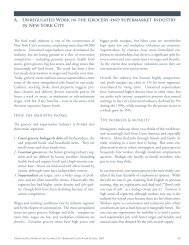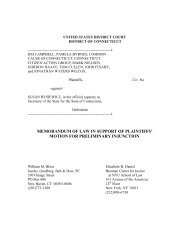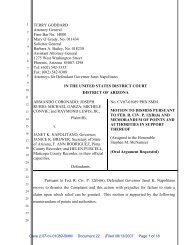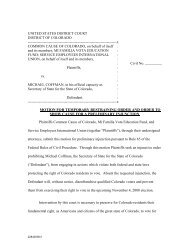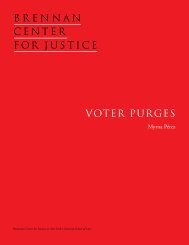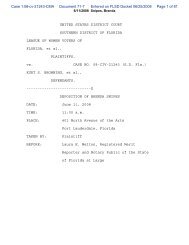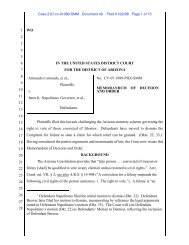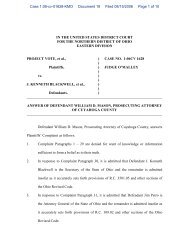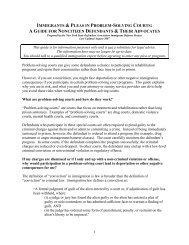Jim Crow in New York
Jim Crow in New York
Jim Crow in New York
You also want an ePaper? Increase the reach of your titles
YUMPU automatically turns print PDFs into web optimized ePapers that Google loves.
Introduction<br />
One of the most extraord<strong>in</strong>ary moments of my life came a year ago as I witnessed my fellow citizens<br />
elect my former student, Barack Obama, as the President of the United States of America. More<br />
African-American and Lat<strong>in</strong>o voters cast a ballot <strong>in</strong> that election than <strong>in</strong> any other election <strong>in</strong> the<br />
country’s history. Then, this June, I experienced great relief as the United States Supreme Court<br />
upheld the constitutionality of Section 5 of the Vot<strong>in</strong>g Rights Act by an 8-1 marg<strong>in</strong>, thus preserv<strong>in</strong>g<br />
our commitment as a nation to vigilantly enforce the vot<strong>in</strong>g rights of all citizens. This is a good<br />
year for all of us who have struggled for an equitable and fair distribution of the franchise.<br />
But protect<strong>in</strong>g the rights of m<strong>in</strong>ority voters is still a full-time job. And, lest we lose our sense of urgency,<br />
the Brennan Center for Justice’s remarkable new report on the historical roots of felony disenfranchisement<br />
<strong>in</strong> the Empire State, <strong>Jim</strong> <strong>Crow</strong> <strong>in</strong> <strong>New</strong> <strong>York</strong>, rem<strong>in</strong>ds us that there is still much work to<br />
do. Felony disenfranchisement laws have stripped the right to vote from two million black Americans.<br />
This number <strong>in</strong>cludes 13% of all African-American men. In <strong>New</strong> <strong>York</strong>, 80% of the roughly 100,000<br />
adults who have lost their right to participate <strong>in</strong> self-government because of a crim<strong>in</strong>al conviction are<br />
black or Lat<strong>in</strong>o. At a time when we congratulate ourselves as a society on our progress <strong>in</strong> the struggle<br />
for racial equality, those of us who refuse to be satisfied until all votes – and all people – are of equal<br />
worth must reenergize to fight aga<strong>in</strong>st felony disenfranchisement laws.<br />
Some might ask why we should be troubled by the high percentage of African Americans who are<br />
disenfranchised because of prior convictions. Isn’t the salient factor crim<strong>in</strong>ality Black, White, Lat<strong>in</strong>o,<br />
or Asian, why should any crim<strong>in</strong>al who is still under the supervision of the state be given the<br />
right to participate <strong>in</strong> government <strong>Jim</strong> <strong>Crow</strong> <strong>in</strong> <strong>New</strong> <strong>York</strong> beg<strong>in</strong>s to answer that question.<br />
When a law can be traced clearly to a racially discrim<strong>in</strong>atory start-po<strong>in</strong>t, the burden of prov<strong>in</strong>g the<br />
absence of racial ta<strong>in</strong>t <strong>in</strong> the current operation of the law should fall on those who seek to justify its<br />
cont<strong>in</strong>ued existence. As readers will discover <strong>in</strong> the pages that follow, suppress<strong>in</strong>g the black vote is<br />
not a legislative purpose that was limited to the deep South. In response to the abolition of slavery<br />
and the passage of the Reconstruction Amendments, legislators <strong>in</strong> <strong>New</strong> <strong>York</strong> sought to prevent free<br />
blacks from vot<strong>in</strong>g by any means possible. And while laws prevent<strong>in</strong>g crim<strong>in</strong>als from vot<strong>in</strong>g extend<br />
back far before the Civil War, those measures are truly benign <strong>in</strong> comparison to the scope and target<br />
of the laws that cont<strong>in</strong>ue to impact – true to their <strong>in</strong>tent – a disproportionate number of would-be<br />
m<strong>in</strong>ority voters today.<br />
This mass silenc<strong>in</strong>g of black Americans is even more troubl<strong>in</strong>g when viewed through the lens of<br />
a discrim<strong>in</strong>atory justice system. Black Americans – and other people of color – are often the recipients<br />
of uneven treatment at all stages of the crim<strong>in</strong>al justice process. From police profil<strong>in</strong>g of<br />
<strong>in</strong>dividuals and communities of color, to the severity of charges brought, the juries selected for trial,<br />
and the punishments imposed, disparate adm<strong>in</strong>istration of the laws results <strong>in</strong> hugely disproportionate<br />
numbers of people of color who are under the supervision of the crim<strong>in</strong>al justice system.<br />
1<br />
Brennan Center for Justice



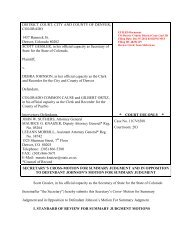
![Download the Letter [PDF] - Brennan Center for Justice](https://img.yumpu.com/50139248/1/190x245/download-the-letter-pdf-brennan-center-for-justice.jpg?quality=85)
